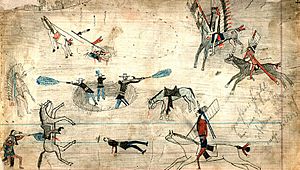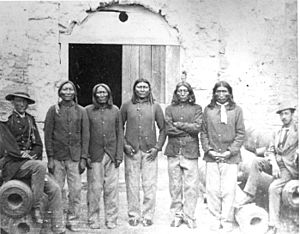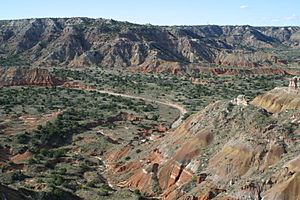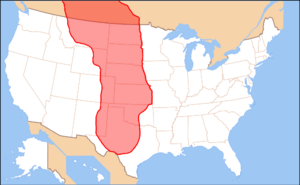Red River War facts for kids
Quick facts for kids Red River War |
|||||||
|---|---|---|---|---|---|---|---|
| Part of the American Indian Wars | |||||||
 A Kiowa ledger drawing possibly depicting the Buffalo Wallow battle in 1874, one of several clashes between Southern Plains Indians and the U.S. Army during the Red River War. |
|||||||
|
|||||||
| Belligerents | |||||||
| Comanche, Kiowa, Southern Cheyenne, Arapaho | |||||||
The Red River War was a military campaign in 1874. The United States Army fought against several Native American tribes. These tribes included the Comanche, Kiowa, Southern Cheyenne, and Arapaho. The goal was to move these tribes from the Southern Plains to special areas called reservations. These reservations were in what is now Indian Territory (Oklahoma).
The war lasted only a few months. Army groups traveled across the Texas Panhandle. They tried to find, bother, and capture the Native American groups. Most fights were small. Neither side lost many people. By late 1874, fewer Native American groups had enough supplies to keep fighting. The last large group surrendered in mid-1875. This war ended the time when Native Americans could roam freely on the southern Great Plains.
Contents
Why the War Started
Before American settlers arrived, Native American tribes on the southern Plains lived a nomadic life. This means they moved around a lot. They followed the buffalo herds. In the 1830s, more settlers began building permanent homes. These homes were often in areas where Native Americans lived. This led to many fights and raids.
During the American Civil War, the U.S. Army left the frontier. Native American raids increased. After the war, the army returned.
The Medicine Lodge Treaty
In 1867, the Medicine Lodge Treaty was signed. It set aside two reservations in Indian Territory. One was for the Comanche and Kiowa. The other was for the Southern Cheyenne and Arapaho. The government promised to give the tribes homes, farming training, and food. In return, the tribes agreed to stop raiding settlements. Many chiefs signed the treaty. Some tribal members moved to the reservations. But the treaty was never fully approved. Also, some Native American groups on the Plains did not attend the talks.
The Buffalo Disappear
In 1867, the U.S. Army started hunting buffalo. This was to cut off the food supply for the Native Americans. By 1870, a new way to tan buffalo hides became popular. Commercial hunters then began hunting buffalo for their hides. There used to be millions of buffalo. But their numbers dropped very quickly. By 1878, almost all of them were gone.
The loss of buffalo was terrible for the Plains Indians. Their entire way of life depended on these animals. Buffalo provided food, fuel, and materials for shelter. Without buffalo, the southern Plains Indians could not support themselves. By the winter of 1873-1874, the tribes were in a difficult situation. Fewer buffalo, more settlers, and army patrols made their lives very hard.
The War Begins
During the winter, a spiritual leader named Isa-tai'i appeared. He was from the Quahadi Band of Comanches. Isa-tai'i claimed he could protect himself and others from enemies, even bullets. He gathered many Native American warriors for large raids. Also, the Kiowa tribe saw a change in leadership. The group that wanted war, led by Chief Guipago (also known as Lone Wolf the Elder), gained more power.
First Fights

On June 27, 1874, Isa-tai'i and Comanche chief Quanah Parker led about 250 warriors. They attacked a small camp of buffalo hunters. This camp was called Adobe Walls in the Texas Panhandle. It had only a few buildings and 28 men and one woman. A few white people died at the start of the Second Battle of Adobe Walls. But most were able to hide inside and fight back. The hunters used powerful buffalo guns. They could shoot from much farther away than the Native Americans expected. The attack failed.
Another fight happened in Texas. Kiowa warriors led by Lone Wolf attacked Texas Rangers in July. This was called the Lost Valley fight. Both sides had few casualties. But it made tensions higher. It also pushed the Army to respond strongly.
The sudden violence surprised the government. The "peace policy" of President Grant was seen as a failure. The Army was allowed to use any force needed to control the southern Plains tribes. At this time, about 1,800 Cheyennes, 2,000 Comanches, and 1,000 Kiowas were still not on reservations. Together, they had about 1,200 warriors.
Battle of Palo Duro Canyon

In early September, Black Seminole Scouts were ahead of the 4th Cavalry. Comanche warriors ambushed them near the Staked Plains. The scouts escaped and told their commander, Mackenzie, where the Comanche were.
The Army's biggest win happened when Mackenzie's scouts found a large village. It belonged to the Comanche, Kiowa, and Cheyenne tribes. It also held their horses and winter food. This village was in upper Palo Duro Canyon. At dawn on September 28, Mackenzie's troops attacked. They moved down a steep canyon wall. The Native Americans were surprised. They did not have time to gather their horses or supplies before leaving. Sergeant John Charlton wrote about the battle:
The warriors held their ground for a time, fighting desperately to cover the exit of their squaws and pack animals, but under the persistent fire of the troops, they soon began falling back.
Only four Native Americans were killed. But the loss was huge. Mackenzie's men burned over 450 lodges. They also destroyed thousands of pounds of buffalo meat. They took 1,400 horses. Most of these horses were shot so the Native Americans could not get them back.
The Battle of Palo Duro Canyon was like most fights in the war, but much bigger. Most battles had few or no deaths. But the Native Americans could not afford to keep losing food and horses. If a group lost their horses and food, they usually had to give up. They would then head for the reservation.
What Happened Next
The Red River War officially ended in June 1875. Quanah Parker and his Quahadi Comanche group surrendered at Fort Sill. They were the last large group of southwestern Native Americans still roaming free. Along with the disappearance of the buffalo, the war opened the Texas Panhandle. Farmers and ranchers could now settle there permanently. This war was the final military defeat for the once-powerful Southern Plains tribes. It also ended the Texas–Indian Wars.


